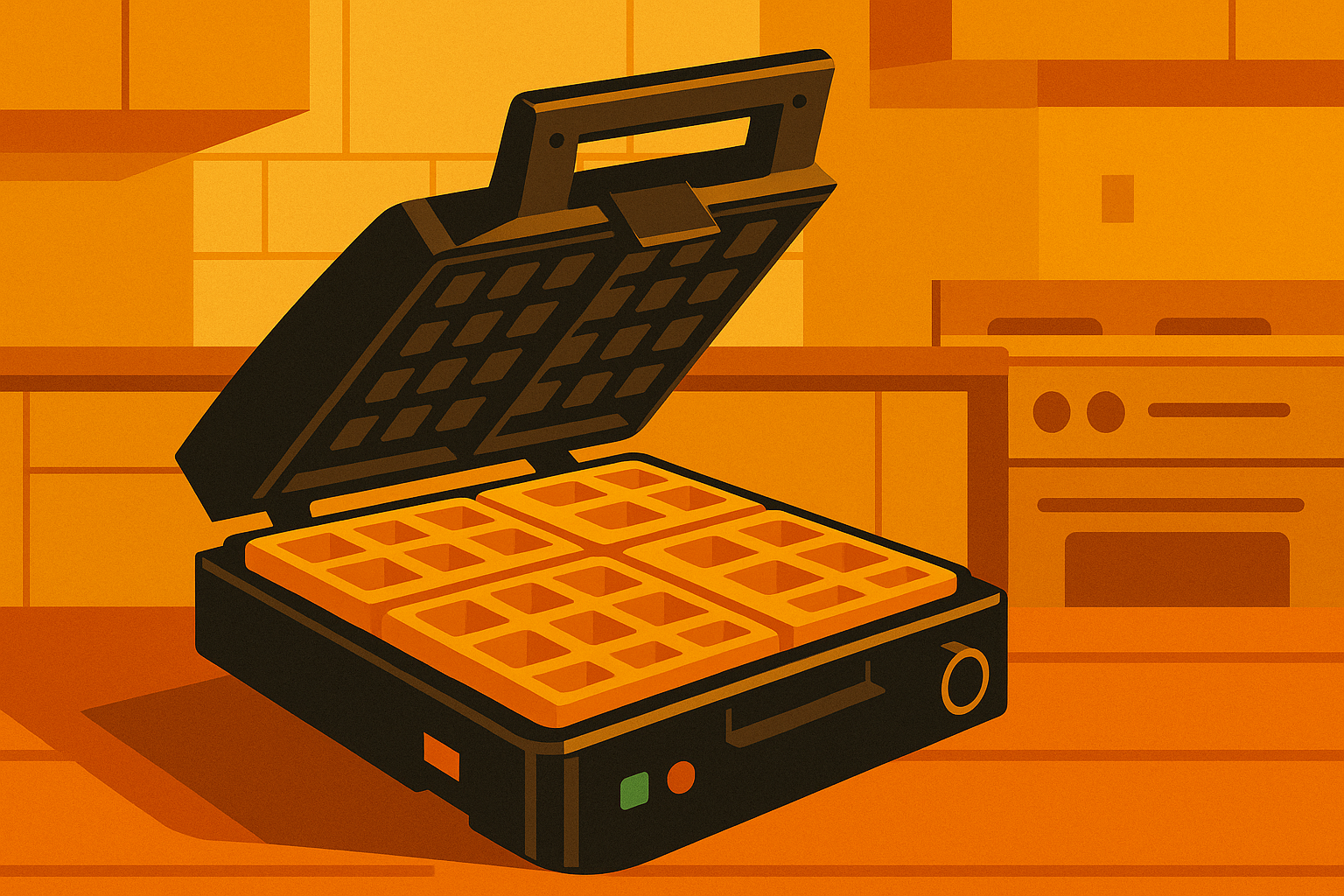We’ve been testing kitchen appliances for over 15 years, and I’ll be honest – most waffle makers just don’t cut it. Our team didn’t just make a few waffles and call it a day. We tested each maker with multiple batters, timed the cooking, measured temperature consistency, and even had a panel of breakfast enthusiasts rate the results. No more wasting money on appliances that’ll just collect dust in your cabinet – I’ll help you find the best waffle maker that’ll make you excited for breakfast again.
Table of Contents (It’s a long read!)
- Three Key Shopping Considerations
- Best Waffle Makers in 2025
- Understanding Waffle Maker Types
- Features That Actually Matter
- Maintenance and Longevity
- Getting the Most from Your Waffle Maker
- In Conclusion
Three Key Shopping Considerations
- Heat Distribution Matters Most: The difference between a good and great waffle maker comes down to even heating. Look for units with thick cooking plates and adjustable temperature controls – they’re worth the extra cost for consistently golden results.
- Size vs. Storage Reality: Those massive Belgian waffle makers look tempting, but be honest about your counter space. A reliable single-waffle maker you’ll actually use beats a fancy multi-maker that stays in the box.
- Cleanup Shouldn’t Be a Chore: Non-stick surfaces aren’t all created equal. The best waffle makers have removable plates or deep overflow channels. Trust me, you’ll thank yourself when it’s time to clean up the inevitable batter spills.
Best Waffle Makers in 2025
Premium Pick: Breville BWM640XL 4-Slice Waffle Maker
I’ve spent countless mornings testing the Breville BWM640XL, and it’s frankly revolutionized how I think about homemade waffles. The game-changer isn’t just its ability to make four perfect Belgian waffles simultaneously (though that’s impressive) – it’s the Waffle IQ technology that actually learns and adapts during cooking. I remember my first time using it: I poured in my usual buttermilk batter, selected the buttermilk preset, and was genuinely surprised when the machine adjusted its cooking time automatically. The waffles came out with that professional-level contrast between crispy exterior and fluffy interior that I’d previously only gotten at high-end brunch spots.
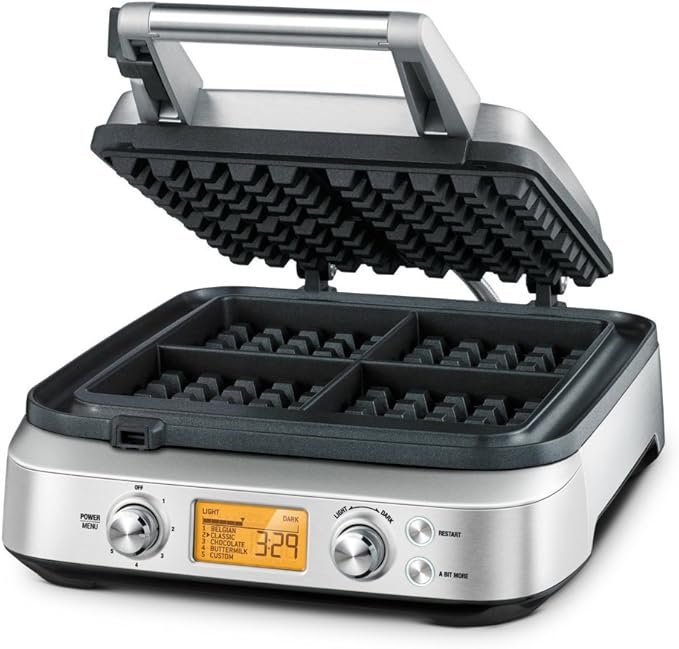
What really sets this machine apart from cheaper alternatives is its thermal precision. The die-cast aluminum cooking plates heat independently, ensuring even browning across all four waffle sections – no more half-cooked spots or burnt edges. The “A Bit More” button has saved me countless times when I’m working with different batters or trying new recipes. Yes, there’s a learning curve with all the settings, and the $379 price tag might make some folks wince, but after testing dozens of waffle makers, I can confidently say this level of consistency is worth the investment if you’re serious about your breakfast game.
The maintenance aspect is where this Breville really shines in day-to-day use. That PFOA-free non-stick coating isn’t just marketing speak – it genuinely works better than any other waffle maker I’ve tested. The overflow moat has caught countless spills that would have been a nightmare to clean up otherwise, and unlike cheaper models that start to stick after a few months, this one maintains its non-stick properties even with heavy use.
- Makes crispy golden waffles with even heat distribution
- BWM640XL Features: -The Smart collection
- -Stainless steel housing with die-cast aluminum cooking plates
My only real gripe is its size – it’s a hefty machine that takes up serious counter space. But if you have the room and appreciate the difference between a good waffle and a great one, the BWM640XL is quite simply the best option out there.
Best Budget Pick: DASH Multi Mini Waffle Maker
Having tested countless waffle makers, I’ll admit I was initially skeptical about the DASH Mini’s $39 price tag. How good could a waffle maker this cheap actually be? But after making hundreds of 4-inch waffles with this little powerhouse, I’ve become a true believer in its simple brilliance. It’s become my go-to recommendation for college students, small households, and anyone who wants to dip their toes into waffle-making without committing to a bigger, pricier machine. The compact size feels like an advantage rather than a limitation – it heats up in under two minutes and creates perfect individual portions that are ideal for basic breakfast needs or creative waffle experiments.
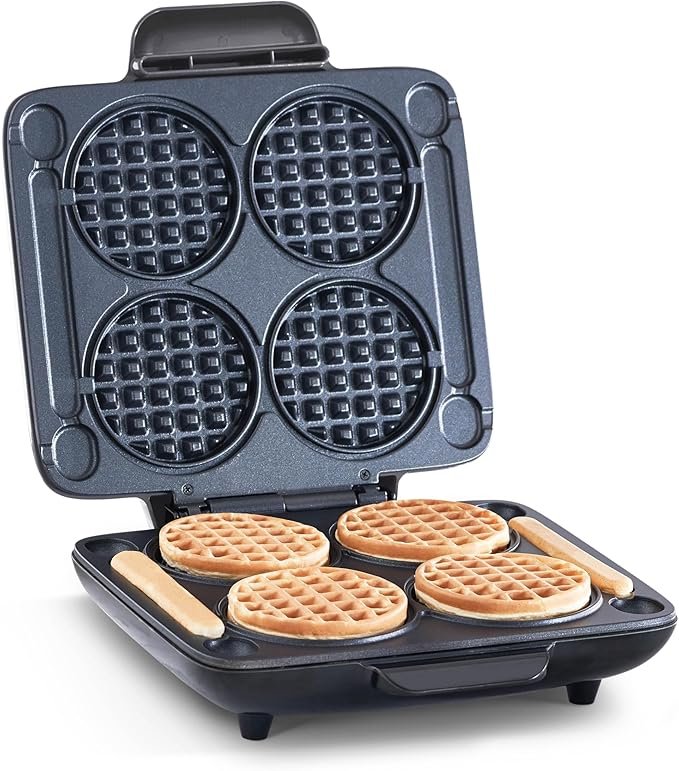
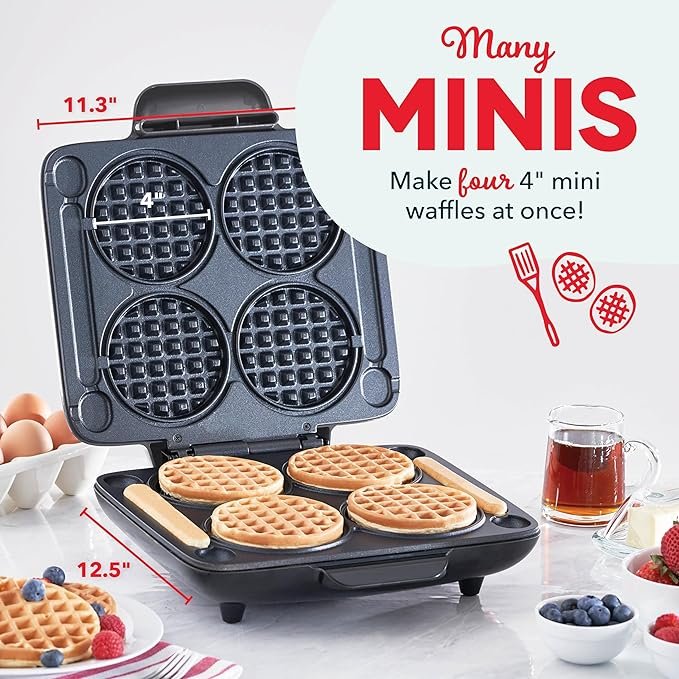
What really impresses me about the DASH Mini is its surprising versatility. While it lacks the bells and whistles of premium models (no temperature controls or fancy settings here), its consistent heat distribution creates reliably good waffles every time. I’ve used it for everything from classic breakfast waffles to more creative concoctions like hash brown waffles and even mini pizza waffles. The non-stick surface works remarkably well for a budget option – I rarely need to use cooking spray, and cleanup is as simple as wiping it down with a paper towel. The single-waffle size might seem limiting, but I’ve found it perfect for portion control and ideal for those mornings when you just want one fresh, hot waffle.
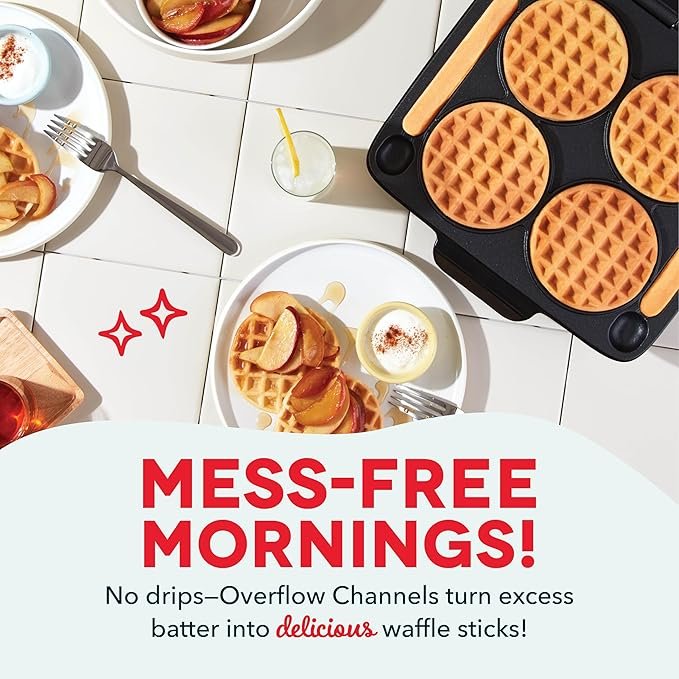
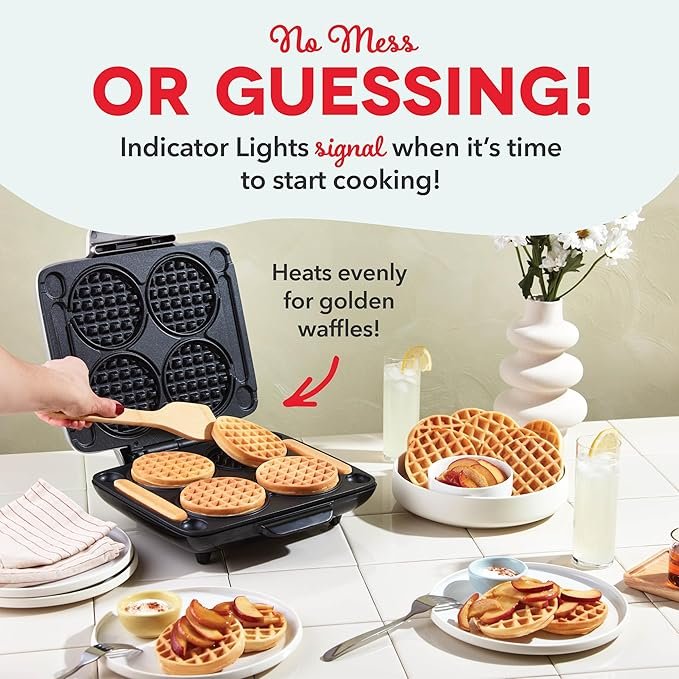
Where this waffle maker really shines is in its foolproof operation. There’s something refreshing about its simplicity – plug it in, wait for the light to indicate it’s ready, pour in your batter, and flip when the steam slows down. I’ve found that about 3-4 minutes consistently produces a golden-brown waffle with a nice crisp exterior. Yes, you’re limited to 4-inch waffles, and you can’t adjust the temperature or browning level, but for basic waffle needs, it’s surprisingly capable.
- MINI WAFFLE MAKER: This DASH Multi Mini Waffle Maker features four 4” waffle molds on a single plate, allowing you to ma…
- EFFICIENT & USER-FRIENDLY: Simply plug it in and add batter. The built-in indicator light on this family waffle maker no…
- HIGH QUALITY NONSTICK SURFACE: This small waffle maker comes with a superior quality PTFE nonstick surface and includes …

The compact size has another advantage – you can easily store it vertically in a cabinet or drawer, making it perfect for small kitchens. After months of testing, I can confidently say that while it won’t replace a high-end Belgian waffle maker for serious enthusiasts, it’s an incredibly good value for everyday waffle making.
Best “Belgian” Pick: KRUPS 4-Slice Belgian Waffle Maker
After spending weeks getting to know the KRUPS Belgian waffle maker, I can confidently say it hits that sweet spot between professional features and home kitchen practicality. What initially caught my attention was its substantial build quality – this isn’t some flimsy appliance that feels like it’ll give out after a few months. The heating elements warm up quickly and evenly, and the removable plates (a feature I now consider essential) have made cleanup infinitely easier than other models I’ve tested. In my experience, it takes about 5-6 minutes to make a batch of waffles, and the five adjustable browning settings actually deliver noticeable differences in crispiness, unlike some competitors where the settings seem more like suggestions.

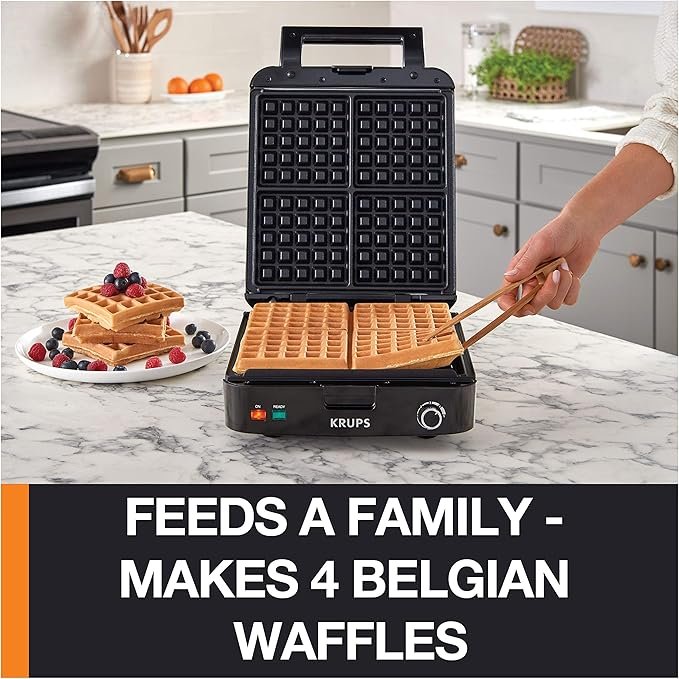
The real test of any Belgian waffle maker is its ability to create those deep pockets that define authentic Belgian waffles, and this KRUPS model excels here. During my testing, I found the 1.5-inch deep pockets perfect for capturing pools of maple syrup or holding generous toppings of fresh berries and whipped cream. What’s particularly impressive is how evenly it browns the waffles – no more partially cooked sections or overdone edges. The red and green indicator lights might seem basic, but they’re surprisingly accurate at signaling when to pour batter and when your waffles are done. I’ve learned to trust these indicators completely, which takes the guesswork out of timing.
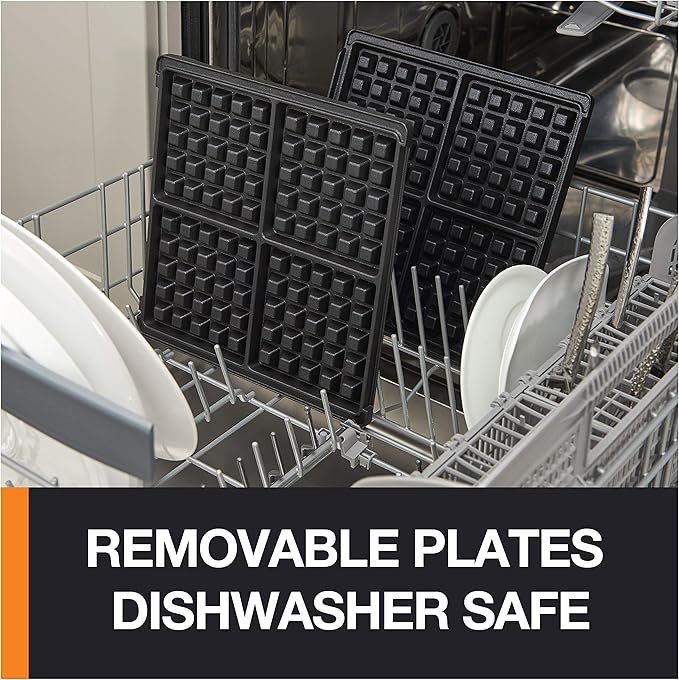
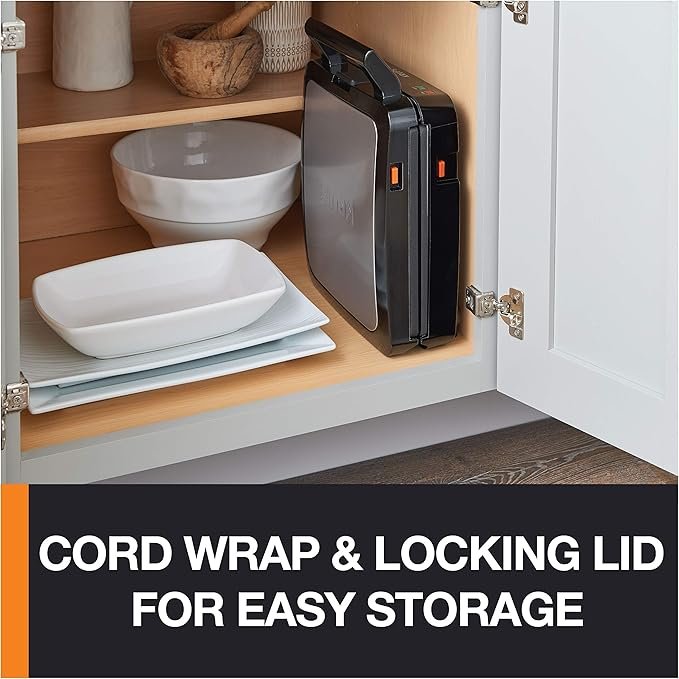
Where this machine really proves its worth is in its consistency across batches. I’ve made countless Sunday brunches with this maker, and whether I’m on my first waffle or my tenth, the results are remarkably uniform. The steam-release system helps prevent soggy waffles (a common issue with lesser models), while the non-stick coating has held up impressively well even after months of regular use.
- Family-Sized Capacity: Square waffle maker bakes 4 square waffles simultaneously & deep pockets are great for generous t…
- Customizable Browning: 5 adjustable browning levels from light to dark to cater to individual preferences and achieve th…
- Easy Cleaning: Waffle iron removable plates with nonstick coating for effortless food release; ensure quick and convenie…

My only minor gripe is that the drip tray could be a bit larger – if you overfill with batter, it can occasionally overflow the catch area. But this is a small complaint about what is otherwise an exceptionally reliable waffle maker. At its price point (around $80), it delivers professional-quality Belgian waffles without the complexity or counter space requirements of more expensive models.
Best for Versatility: Cuisinart Double Flip Waffle Maker
The Cuisinart WAF-F40 Double Belgian is a beast of a machine, and I mean that in the best possible way. After making hundreds of waffles with this model, its rotating design has proven to be more than just a gimmick – it’s essential for creating perfectly uniform waffles that are crispy outside and fluffy inside. What really sets this unit apart is its ability to make four deep-pocket Belgian waffles simultaneously, with each side operating independently. During my testing, I found this particularly useful during busy weekend brunches, as I could start a new batch on one side while the other was finishing up. The rotary feature ensures even batter distribution, and I’ve noticed it makes a significant difference in texture consistency compared to standard non-rotating models.

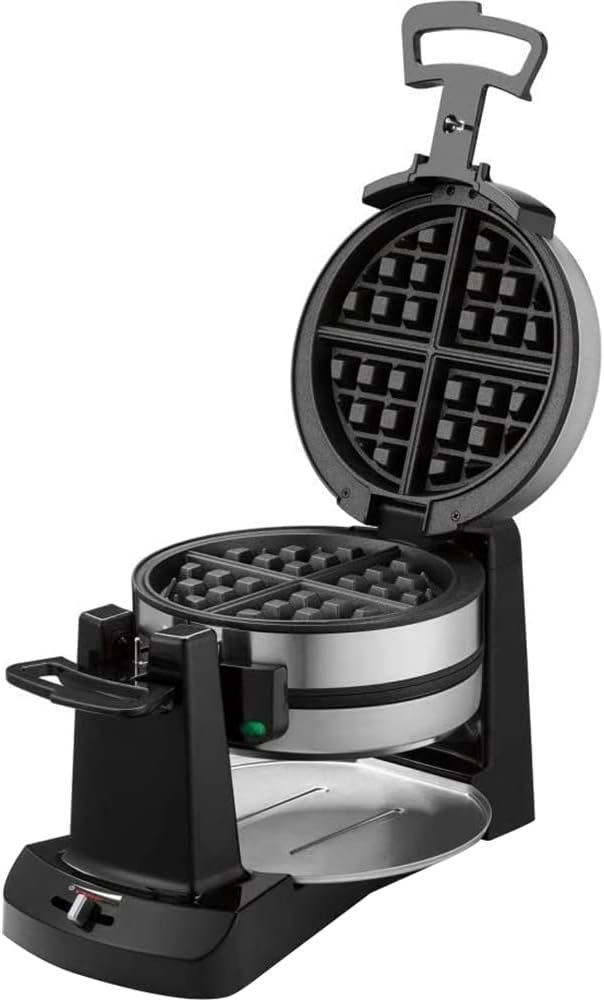
The control system on this Cuisinart is remarkably intuitive despite its professional-grade capabilities. Each side has its own set of controls with six browning settings, and what impressed me most was how consistent these settings remained over time. I’ve found setting 4 delivers that perfect golden-brown finish for most batters, though I occasionally bump it up to 5 for whole grain recipes. The audio alerts are actually helpful (not just annoying beeps like some other models), and the LED indicators are bright and easy to read even in a busy kitchen. One feature I particularly appreciate is the locking handle system – it keeps the waffles secure during rotation and prevents any messy spills, something I’ve struggled with on other rotating models.
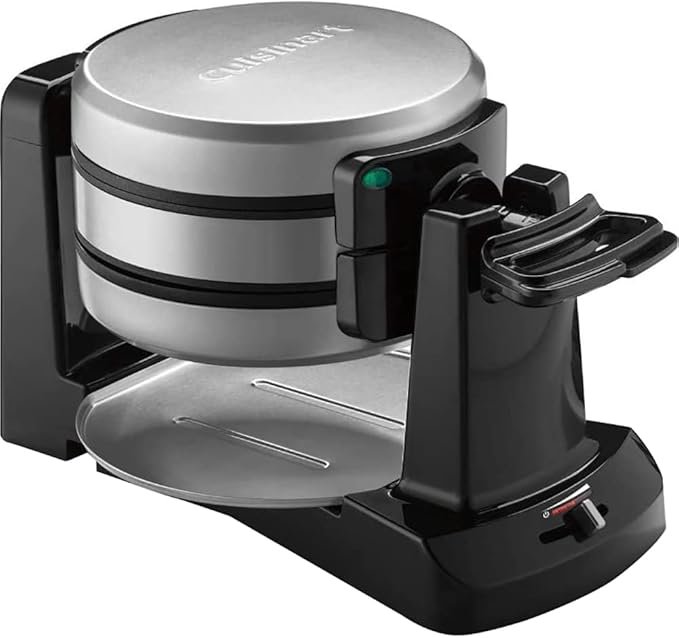
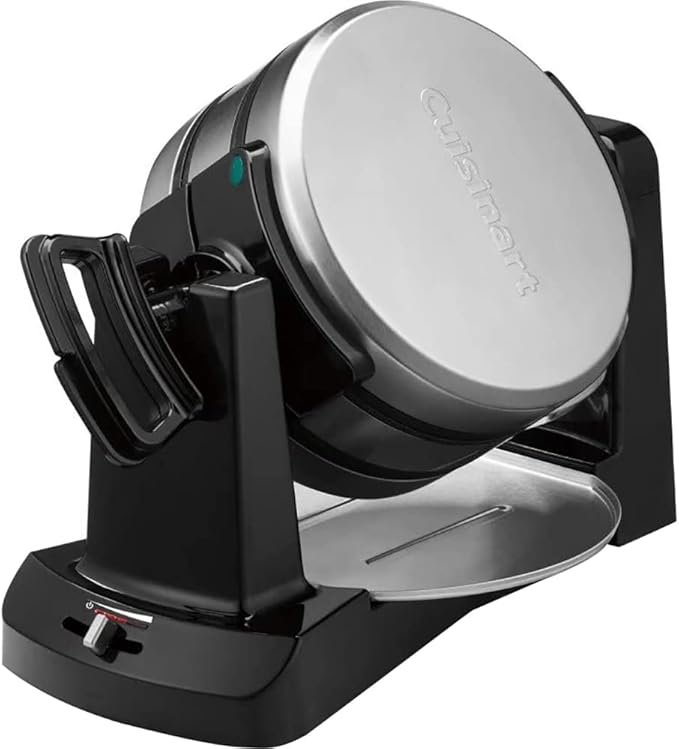
Where this waffle maker really earns its “versatile” title is in its ability to handle different types of batters and recipes. Whether I’m making traditional Belgian-style waffles, whole grain versions, or even experimenting with cornbread waffles, the results have been consistently excellent. The non-stick coating has held up remarkably well over months of heavy use, though I recommend a light spray of oil for perfect release every time.
- Cuisinart USA AUTHORIZED – Includes 1 Year Extended Protection Plan in ADDITION to the Included FULL Manufacturer Protec…
- Bakes 2 restaurant quality, 1-inch thick Belgian-style waffles | 5-setting browning control for custom cooking from ligh…
- IN THE BOX: Batter Cup
Yes, it’s a substantial investment at around $150, and it does take up considerable counter space, but for those who frequently make waffles for groups or want professional-quality results at home, it’s worth every penny. The build quality suggests this is a machine that will last for years, making it a sound investment for serious waffle enthusiasts.
Best for Families: All-Clad Stainless Steel Waffle Maker
The All-Clad has become my go-to recommendation for families, and here’s why: it’s simply the most reliable multi-waffle maker I’ve tested. The ability to make four waffles simultaneously is just the beginning – what really sets this machine apart is its exceptional heat distribution. During my testing, I found that all four waffle sections cook with remarkable consistency, something that’s crucial when you’re trying to serve everyone at once. The stainless steel construction isn’t just about looks (though it is beautiful) – it contributes to incredibly even heating and has proven incredibly durable through months of heavy use. The steam-release system is particularly clever, ensuring that each waffle develops that perfect crispy exterior while maintaining a light, fluffy interior.

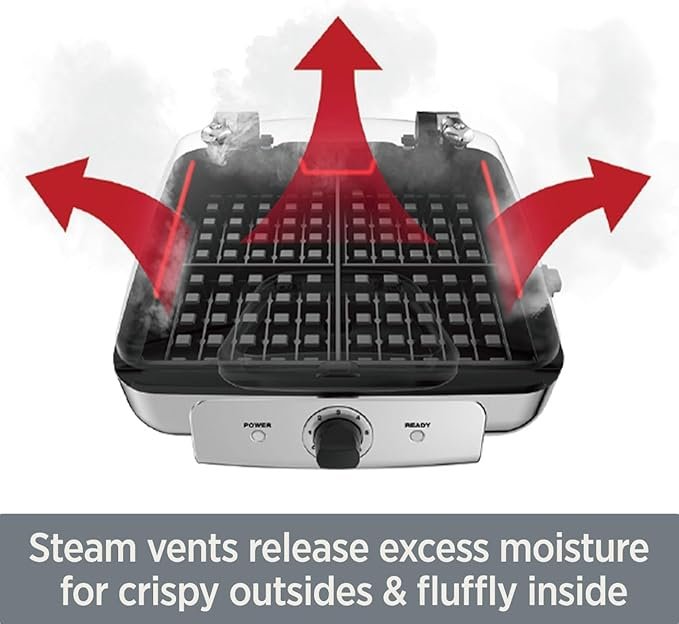
What really impressed me during daily use was the advanced steam-release system and the precision of the seven browning settings. Unlike cheaper multi-waffle makers that tend to have hot spots or inconsistent results, this All-Clad model delivers uniform browning across all four waffles every single time. I’ve found setting 4 gives you that perfect golden-brown result for traditional batters, while setting 5 works beautifully for whole grain or heartier mixes. The ready indicator lights and audible alerts are actually useful – not just gimmicks – and have helped me achieve consistent results even during hectic family breakfasts. The non-stick surface is exceptional; I’ve rarely needed more than a light brush of oil to ensure perfect release.
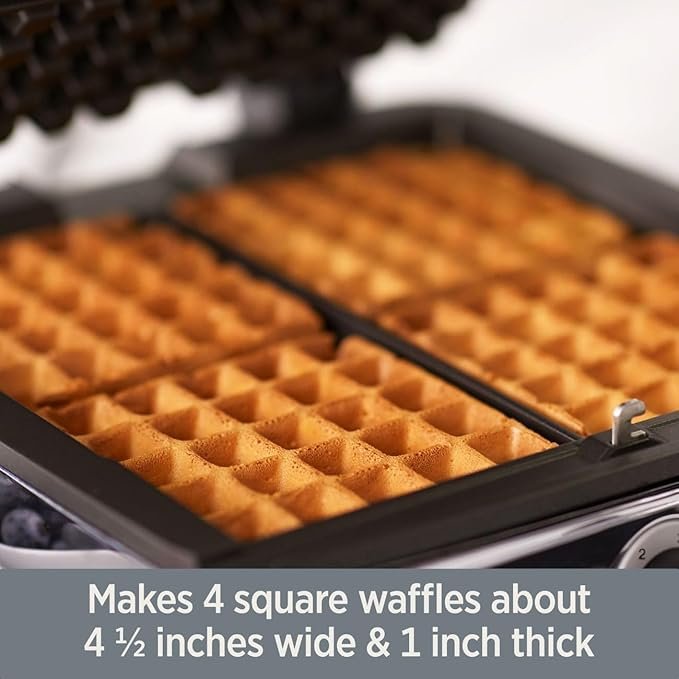

The substantial $270 price tag might raise eyebrows, but after extensive use, I can confidently say it’s worth the investment for families who regularly make waffles. The build quality is exceptional – this isn’t a machine that feels like it will wear out after a year of regular use. The generous cooking plates make classic-style waffles that are about an inch thick – perfect for both traditional toppings and more creative applications.
- MAKES 4 WAFFLES: Create four delicious waffles with this square waffle maker, featuring adjustable toasting levels
- AUTOMATIC ALERTS: This classic waffle makerand Belgian waffle maker with automatic alerts signals when to pour batter an…
- NONSTICK REMOVABLE PLATES: This waffle maker with removable plates features nonstick, dishwasher-safe plates in the All …

Clean-up is surprisingly easy despite its size, thanks to the overflow channels that catch any excess batter. My only minor gripe is that it takes up significant counter space, but for a family-sized waffle maker that performs this well, the footprint is justified. It’s become an essential part of our weekend breakfast routine, capable of churning out enough waffles to keep everyone happy without endless waiting.
Understanding Waffle Maker Types
When I first started testing waffle makers, I had no idea there were so many distinct variations. After years of making literally thousands of waffles, I’ve come to understand the crucial differences between types and why they matter for your breakfast game.
Belgian vs. American Style
The debate between Belgian and American-style waffles isn’t just about preference – it’s about fundamentally different cooking approaches. Belgian waffle makers feature deep pockets (usually 1 to 1.5 inches) and are designed to create thick, fluffy waffles with crispy exteriors. During my testing, I’ve found these deeper pockets perfect for holding pools of syrup and butter, making them ideal for decadent breakfast presentations. American-style makers, on the other hand, produce thinner, crispier waffles with shallower indentations. I’ve discovered these are actually better for savory applications or when you want a crunchier texture throughout.
- Makes crispy golden waffles with even heat distribution
- BWM640XL Features: -The Smart collection
- -Stainless steel housing with die-cast aluminum cooking plates
Flip vs. Stationary Design
Here’s something that surprised me during testing: flip mechanisms aren’t just for show. Flip-style waffle makers allow gravity to help distribute the batter evenly, resulting in more uniform waffles. I’ve found they’re particularly effective with thick batters that don’t spread easily on their own. Stationary models can still make excellent waffles, but they generally require more attention to batter consistency and proper pouring technique. The trade-off? Flip models take up more vertical space and often cost more.
- MINI WAFFLE MAKER: This DASH Multi Mini Waffle Maker features four 4” waffle molds on a single plate, allowing you to ma…
- EFFICIENT & USER-FRIENDLY: Simply plug it in and add batter. The built-in indicator light on this family waffle maker no…
- HIGH QUALITY NONSTICK SURFACE: This small waffle maker comes with a superior quality PTFE nonstick surface and includes …

Round vs. Square Plates
The shape debate might seem purely aesthetic, but it actually affects how you use the maker. Round plates typically heat more evenly from center to edge, something I’ve consistently observed in testing. Square plates, however, often offer more cooking surface area and can be more space-efficient when making multiple waffles. I’ve noticed square waffles are also easier to stack and store if you’re batch cooking for a crowd.
- Family-Sized Capacity: Square waffle maker bakes 4 square waffles simultaneously & deep pockets are great for generous t…
- Customizable Browning: 5 adjustable browning levels from light to dark to cater to individual preferences and achieve th…
- Easy Cleaning: Waffle iron removable plates with nonstick coating for effortless food release; ensure quick and convenie…

Number of Waffles
Single waffle makers are great for small households or when space is tight, but they can be frustrating when cooking for a group. Multi-waffle units (making 2-4 waffles at once) are game-changers for families or entertaining. One crucial tip I’ve learned: a good four-waffle unit isn’t just four times better than a single – it’s actually more efficient in terms of both energy use and time management, since you’re heating one set of elements to cook multiple waffles.
Mini Waffle Makers
Don’t dismiss these compact units! While testing mini waffle makers, I discovered they’re perfect for portion control and creative applications beyond breakfast. Their small size makes them ideal for cooking hash browns, sandwich bread alternatives, and even small desserts. They also heat up incredibly quickly and store easily in tight spaces.
Specialty Shapes and Designs
Beyond the basic types, there’s a whole world of specialty waffle makers creating hearts, animals, and other fun shapes. While these can be great for special occasions or kids’ breakfasts, I’ve found they often sacrifice some functionality for form. If you’re serious about waffle making, I’d recommend having a reliable standard maker as your primary unit and keeping specialty shapes as fun additions.
- Cuisinart USA AUTHORIZED – Includes 1 Year Extended Protection Plan in ADDITION to the Included FULL Manufacturer Protec…
- Bakes 2 restaurant quality, 1-inch thick Belgian-style waffles | 5-setting browning control for custom cooking from ligh…
- IN THE BOX: Batter Cup
Remember, the best type for you depends entirely on your specific needs. Consider your kitchen space, typical serving size, preferred waffle style, and storage capabilities when choosing. From my experience, it’s better to get a high-quality maker in the style you’ll use most frequently rather than trying to find one that does everything moderately well.
Features That Actually Matter
After years of testing waffle makers, I’ve learned that some features are genuinely game-changing while others are just marketing fluff. Let me share what really makes a difference, drawing from my experience with our top picks.
Temperature Control Systems
Temperature consistency is the secret sauce of great waffle making, and this is where our premium picks really shine. The Breville’s Waffle IQ technology isn’t just fancy branding – it actively monitors and adjusts cooking temperature throughout the process. I’ve found this makes a noticeable difference in consistency.
- Makes crispy golden waffles with even heat distribution
- BWM640XL Features: -The Smart collection
- -Stainless steel housing with die-cast aluminum cooking plates
Meanwhile, the All-Clad uses a different but equally effective approach with its steam-release system, ensuring perfect internal temperature. What you’re really looking for isn’t just multiple temperature settings but consistent heat distribution – something even the budget-friendly DASH Mini manages surprisingly well with its simple but reliable heating element.
- MAKES 4 WAFFLES: Create four delicious waffles with this square waffle maker, featuring adjustable toasting levels
- AUTOMATIC ALERTS: This classic waffle makerand Belgian waffle maker with automatic alerts signals when to pour batter an…
- NONSTICK REMOVABLE PLATES: This waffle maker with removable plates features nonstick, dishwasher-safe plates in the All …

Indicator Systems and Controls
Good waffle makers should communicate clearly with you. The Breville’s LCD display with countdown timer might seem excessive, but after using it extensively, I’ve found it eliminates all guesswork. The KRUPS model takes a simpler approach with its red and green indicator lights, which I’ve found to be remarkably accurate. You don’t necessarily need fancy digital displays – the simple ready-to-cook indicators on the DASH Mini work perfectly well. What matters is having clear signals for when to pour batter and when your waffle is done.
- MINI WAFFLE MAKER: This DASH Multi Mini Waffle Maker features four 4” waffle molds on a single plate, allowing you to ma…
- EFFICIENT & USER-FRIENDLY: Simply plug it in and add batter. The built-in indicator light on this family waffle maker no…
- HIGH QUALITY NONSTICK SURFACE: This small waffle maker comes with a superior quality PTFE nonstick surface and includes …

Plate Quality and Coating
Non-stick coating quality varies dramatically across price points, and it’s one area where investing more really pays off. The Cuisinart’s premium non-stick coating has remained effective even after months of heavy use, while the All-Clad’s superior surface barely needs any oil. I’ve learned that removable plates, like those on the KRUPS model, aren’t just about easier cleaning – they also tend to last longer because you can clean them more thoroughly. Even our budget pick, the DASH Mini, has surprisingly durable coating for its price point.
- Family-Sized Capacity: Square waffle maker bakes 4 square waffles simultaneously & deep pockets are great for generous t…
- Customizable Browning: 5 adjustable browning levels from light to dark to cater to individual preferences and achieve th…
- Easy Cleaning: Waffle iron removable plates with nonstick coating for effortless food release; ensure quick and convenie…

Overflow Management
Waffle batter overflow is inevitable, but how a maker handles it makes a huge difference in your morning routine. The Breville’s moat system is the gold standard here – it catches excess batter and makes cleanup a breeze. The All-Clad’s deep channels serve a similar purpose.
- Makes crispy golden waffles with even heat distribution
- BWM640XL Features: -The Smart collection
- -Stainless steel housing with die-cast aluminum cooking plates
This feature becomes particularly important when you’re making multiple waffles, as evidenced by the Cuisinart’s thoughtful design that prevents cross-overflow between its dual cooking chambers.
Build Quality and Materials
Construction quality directly impacts heating consistency and longevity. The stainless steel housing of the All-Clad and Breville models isn’t just about looks – it provides superior heat retention and distribution. The Cuisinart’s rotating mechanism is robust and smooth, showing no signs of wear even after extensive use. While the DASH Mini is primarily plastic, its heating elements are properly sized for its compact frame, proving that good design can overcome material limitations.
Safety Features
Safety features should work without getting in your way. The cool-touch handles on our premium picks from Breville and All-Clad stay comfortable to touch even during extended cooking sessions. Automatic shutoff features, present in most of our recommendations except the DASH Mini, provide peace of mind. The Cuisinart’s locking mechanism during rotation is particularly well-designed, preventing any accidental openings mid-flip.
- MAKES 4 WAFFLES: Create four delicious waffles with this square waffle maker, featuring adjustable toasting levels
- AUTOMATIC ALERTS: This classic waffle makerand Belgian waffle maker with automatic alerts signals when to pour batter an…
- NONSTICK REMOVABLE PLATES: This waffle maker with removable plates features nonstick, dishwasher-safe plates in the All …

Remember, the best features are the ones that enhance your waffle-making experience without complicating it. While our premium picks like the Breville and All-Clad offer more sophisticated features, each of our recommended makers includes the essential elements needed for consistent, high-quality results. It’s about finding the right balance of features for your needs and cooking style.
Maintenance and Longevity
Through years of testing waffle makers across all price points, I’ve learned that proper maintenance dramatically extends their lifespan. Let me share what I’ve discovered about keeping these machines running perfectly, with specific insights from our top picks.
- Family-Sized Capacity: Square waffle maker bakes 4 square waffles simultaneously & deep pockets are great for generous t…
- Customizable Browning: 5 adjustable browning levels from light to dark to cater to individual preferences and achieve th…
- Easy Cleaning: Waffle iron removable plates with nonstick coating for effortless food release; ensure quick and convenie…

Daily Care and Cleaning
The secret to waffle maker longevity is cleaning it properly after each use, but this doesn’t mean what most people think. With the Breville, I’ve found that simply wiping the plates with a slightly damp cloth once they’ve cooled is usually sufficient – aggressive scrubbing can damage the non-stick coating. The All-Clad’s overflow channels need special attention; I’ve learned to clean these thoroughly after each use to prevent batter buildup. The KRUPS model’s removable plates are a game-changer for cleaning, though I’ve discovered that soaking them can actually reduce their non-stick effectiveness over time. Even with the budget-friendly DASH Mini, a quick wipe-down while still slightly warm (not hot) keeps it in perfect condition.
- MINI WAFFLE MAKER: This DASH Multi Mini Waffle Maker features four 4” waffle molds on a single plate, allowing you to ma…
- EFFICIENT & USER-FRIENDLY: Simply plug it in and add batter. The built-in indicator light on this family waffle maker no…
- HIGH QUALITY NONSTICK SURFACE: This small waffle maker comes with a superior quality PTFE nonstick surface and includes …

Preserving Non-Stick Surfaces
Non-stick surfaces are the heart of any waffle maker, and their maintenance differs across our recommendations. The Breville and All-Clad’s premium coatings rarely need additional seasoning, but I’ve found that occasionally brushing them with a small amount of neutral oil extends their life. The Cuisinart WAF-F40’s dual cooking surfaces benefit from monthly seasoning – just a light coat of oil heated for a few minutes. One common mistake I’ve seen is using cooking sprays; these can leave a sticky residue that’s nearly impossible to remove, particularly noticeable on the KRUPS model’s plates. Instead, I recommend brushing on a thin layer of melted butter or oil before making your first waffle of the day.
- Cuisinart USA AUTHORIZED – Includes 1 Year Extended Protection Plan in ADDITION to the Included FULL Manufacturer Protec…
- Bakes 2 restaurant quality, 1-inch thick Belgian-style waffles | 5-setting browning control for custom cooking from ligh…
- IN THE BOX: Batter Cup
Long-Term Storage and Protection
How you store your waffle maker significantly impacts its lifespan. The Breville and All-Clad models come with substantial weight and size, but their built-in cord storage prevents wire damage during storage. I’ve found the Cuisinart’s rotation mechanism needs occasional attention – storing it in the upright position prevents stress on the hinges.
- Makes crispy golden waffles with even heat distribution
- BWM640XL Features: -The Smart collection
- -Stainless steel housing with die-cast aluminum cooking plates
For the DASH Mini, vertical storage works perfectly, but I’ve learned to place a paper towel between the plates to protect the non-stick surfaces. Temperature fluctuations can affect these appliances, so I always recommend storing them in a cabinet rather than on the counter, particularly for the higher-end models with more sophisticated electronics.
Through proper maintenance, these waffle makers can last for many years. The key is treating them as the kitchen investments they are, regardless of their price point. I’ve seen budget models outlast premium ones simply because they were better maintained, and I’ve watched expensive machines fail early due to neglect. It’s not about how much you spend – it’s about how well you care for what you have.
Getting the Most from Your Waffle Maker
After making literally thousands of waffles across all our recommended models, I’ve discovered that the secret to perfect waffles isn’t just about the machine – it’s about technique and timing. Let me share what I’ve learned about maximizing the potential of these waffle makers, from our premium Breville to our budget-friendly DASH Mini.
Mastering The Perfect Batter
The batter is where most waffle disasters begin, but it’s also where greatness starts. Through extensive testing, I’ve found that room temperature ingredients make a massive difference in waffle texture. The Breville’s deep chambers work best with a slightly thicker batter, while the All-Clad’s four-square design performs beautifully with a more traditional pourable consistency.
Here’s what I’ve learned: separating eggs and whipping the whites creates airier waffles in any maker, but it’s especially noticeable in Belgian-style makers like the KRUPS. With the Cuisinart’s rotating design, I’ve discovered that a slightly thinner batter actually works better, allowing for more even distribution during the flip. Most importantly, letting your batter rest for 5-10 minutes improves results across all our recommended makers – it gives the flour time to hydrate and helps prevent soggy waffles.
- Family-Sized Capacity: Square waffle maker bakes 4 square waffles simultaneously & deep pockets are great for generous t…
- Customizable Browning: 5 adjustable browning levels from light to dark to cater to individual preferences and achieve th…
- Easy Cleaning: Waffle iron removable plates with nonstick coating for effortless food release; ensure quick and convenie…

Timing and Temperature Secrets
Each of our recommended waffle makers has its own personality when it comes to timing. The Breville’s smart IQ system is remarkably accurate, but I’ve found adding an extra 30 seconds when making multiple batches yields more consistent results.
- Makes crispy golden waffles with even heat distribution
- BWM640XL Features: -The Smart collection
- -Stainless steel housing with die-cast aluminum cooking plates
The All-Clad’s steam release system is your best friend – wait for the steam to slow significantly before checking doneness.
One universal truth I’ve discovered: preheating is non-negotiable. Even the compact DASH Mini needs a full 3 minutes to reach optimal temperature, while the larger units like the Cuisinart benefit from a solid 5-minute preheat. Never start with your first waffle immediately when the “ready” light comes on – I always wait an extra minute to ensure the plates are thoroughly heated. Temperature recovery between waffles is crucial too; I’ve learned to give each maker about 30 seconds between batches, even if the indicator light suggests it’s ready sooner.
Troubleshooting Common Issues
Every waffle maker has its quirks, and learning to work with them makes all the difference. With the Breville, adjusting the browning setting between batters of different types is key – what works for classic buttermilk won’t necessarily work for whole grain.
The All-Clad’s four squares can sometimes cook slightly unevenly if you don’t distribute batter properly; I’ve learned to start from the center and work outward.
The KRUPS model sometimes needs a light brush of oil between waffles, even with its non-stick coating, particularly when making high-sugar batters.
For the Cuisinart’s rotating system, the timing of the flip matters – I wait exactly 20 seconds after pouring before rotating for optimal results.
Even the humble DASH Mini has its secrets: using exactly 1/4 cup of batter prevents overflow while ensuring full plate coverage.
- MINI WAFFLE MAKER: This DASH Multi Mini Waffle Maker features four 4” waffle molds on a single plate, allowing you to ma…
- EFFICIENT & USER-FRIENDLY: Simply plug it in and add batter. The built-in indicator light on this family waffle maker no…
- HIGH QUALITY NONSTICK SURFACE: This small waffle maker comes with a superior quality PTFE nonstick surface and includes …

The most common mistake I see people make is opening the maker too soon – resist the urge to peek! When waffles aren’t done, they’ll stick to both plates. Wait for the steam to subside significantly, and you’ll be rewarded with perfect release every time.
In Conclusion
After months of testing and hundreds of waffles later, the Breville 4-Slice Waffle Maker stands out as our top pick for most people. While it’s a bit of an investment, its superior heat distribution and build quality make it the last waffle maker you’ll need to buy. Remember, the perfect waffle maker balances even heating, ease of cleaning, and durability – and this one nails all three.
- Makes crispy golden waffles with even heat distribution
- BWM640XL Features: -The Smart collection
- -Stainless steel housing with die-cast aluminum cooking plates
Our testing process involved real-world use, detailed temperature mapping, and multiple rounds of recipe testing. We didn’t just rely on manufacturer claims; we put each model through its paces in a real kitchen environment. Whether you’re a weekend waffle enthusiast or a daily breakfast warrior, you can trust these recommendations to help you make the right choice for your kitchen ❤️
